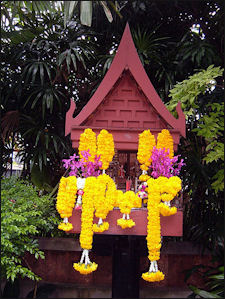NATIVE RELIGIONS
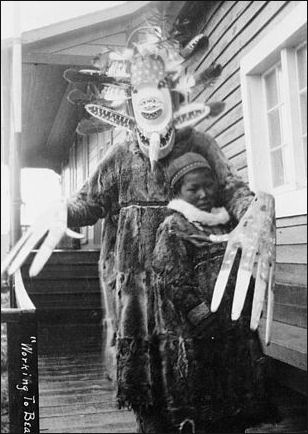
Yupik shaman in Nushagak, Alaska Native religions are ones that are practiced on a small scale by particular families, tribes, communities and ethic groups. In the past they were quite common but now have largely been replaced or absorbed by larger, organized religions such as Christianity. Those that survive are likely to be found in remote places with relatively little contact with the outside world. Some native religions continues to exist in a form influenced by or incorporated into a more dominant religion. Many local gods and practices live on as saints or rituals within the Christian church.
Native religions vary a great deal from place to place and community to community but many of them have a large number of spiritual beings, such as tree spirits, mountain gods and ancestors, that are involved in wide range of activities. The human leaders are often healers or shaman who have the power to communicate with these spirits, often in another realm.
Native religions often have some kind of belief about the spirit possession of humans, which can cause diseases or some other malady or can be involved in a ritual, rite of passage or communication with another world. There is also some general recognition of evil, evil power and evil spirits and lessons and advice on how to deal with them through magic, faith or good deeds and behavior.
Rituals often hold great importance in native religions. They are often used in healing and to symbolize important natural and life-cycle process such for planting, harvesting, coming of age, marriage or a funeral. Myths, legends and oral traditions also hold a high place and are used to answer the big question of life, explain their beliefs, record history and pass down information from one generation to the next.
SHAMANISM IN SIBERIA AND RUSSIA factsanddetails.com; ANIMISM, SHAMANISM AND ANCESTOR WORSHIP IN EAST ASIA (JAPAN, KOREA, CHINA) factsanddetails.com ; SHAMANISM AND FOLK RELIGION IN MONGOLIA factsanddetails.com
Magical Thinking
Magical thinking — beliefs by individuals that their thoughts and beliefs can produce a desired outcome — are very common, scholars say. There seems to be an evolutionary and physiological explanation: that beliefs in special powers can provide a lift in particularly stressfully situations and help one deal with the wears and tears of everyday life, though the idea should not to be confused with religious beliefs which incorporates large questions about morality, existence, community and history.
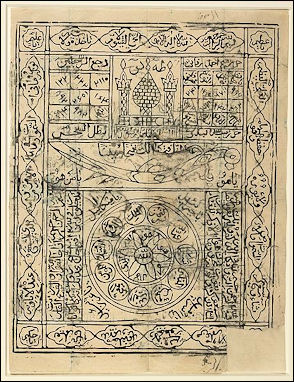
Shiite Muslim stamped amulet In series of experiments performed by Harvard and Princeton psychologists in the summer of 2006 , well-educated adults were asked to watch a blindfolded player play an arcade basketball game and visualize success for the player. Unknown to the subjects was that the game was rigged and the players could see through the blindfold and practiced extensively to make the shot. When asked on a questionnaire if the observers had some impact on the player success many said yes. Subjects responded similarly in an experiment using voodoo dolls on people that feigned headaches and when asked if their actions affected the result of the 2005 Super Bowl.
Princeton’s Emily Pronin, the leader of the study told the New York Times, “The question is why did people create this illusion of magical power? I thinks in part it’s because we’re constantly exposed to our own thoughts — they are most salient to use — and thus we are likely to overestimate their connection to outside events.
Children exhibit a form of magical thinking by about 18 months when they create imaginary worlds while playing. By age three they know the difference between fantasy and reality but still believe in Santa Claus and the Tooth Fairy, By age 8, and sometimes earlier, they have given up on Santa Claus and their beliefs about magic and reality are as clear cut as when they are adults. Some social scientists believe that this is when they start thinking about religion and faith. Jacqueline Woolley, a professor of psychology at the University of Texas, told the New York Times, “The point at which the culture withdraws support for belief in Santa and the Tooth Fairy is about the same time it introduces children to prayer. The mechanism is already there, kids have already spent time believing that wishing makes things come true, and they’re just losing faith in the efficacy of that.’
Animism
Animism refers to the collective worship of spirits and dead ancestors rather than individual gods. Derived from “anima” , the Latin word for soul, it was coined in 1871 by Edward Taylor to describe a theory of religion. Animism and ancestor worship are often closely linked. Animism is not the worship of animals.
Animism emphasizes a reverence for all living things. Many animists believe that every living thing and some non-living ones too — even trees and insects and things like special rocks and landscape formations — have a spirit. Commonly these spirits merge with other spirits such as a common river or forest spirit and a general life spirit. Some spirits are conjured up before a tree is chopped down or food is eaten to appease them. Others are believed to be responsible for fighting disease or promoting fertility. Animist spirits are often associated with places or objects because they were thought to live close by.
Many anthropologists believe that animism developed out of the belief in some cultures that natural spirits and dead ancestors exist because they appear in dreams and visions. Other anthropologists speculate that the idea of spirits developed among early men out of the concept that something alive contains a spirit and something dead doesn’t, and when something alive dies its spirit has to go somewhere.
Spirits and Unhappy Ancestors
Thai Spirit HouseMany animists believe that every living thing, even trees and insects, have a spirit. Commonly these spirits merge with other spirits such as a common river or forest spirit and a general life spirit. Animists also believe many non-living things such as rocks and water possess spirits. Among the important supernatural forces are aloof spirits that dwell in the mountains, rivers and the sky; and the evil spirits, often the forest-roaming souls of the dead ancestors who for one reason or another are not at peace.
Animists believe that things like weather and disease are caused by spirits. They also believe that the deceased become spirits that can bring bad fortune or good fortune depending on how they are treated when they were alive and when they are dead.
Unhappy dead ancestors are greatly feared and every effort is made to make sure they are comfortable in the hereafter. Accidents and illnesses are often attributed to deeds performed by the dead and cures are often attempts to placate them. In some societies, people go out of their way to be nice to one another, especially older people, out of fear of what they might do when they die.
Almost every aspect of the life of some ethnic minorities revolves around making sure that spirits are happy and placated. A lot of time is taken up making sure the hundreds of different spirits that occupy the hills and the forest are fed and cared for.
Ritual life takes many forms. Pigs, chickens and buffalo are sacrificed to appease ancestors and ghosts; trees are not cut down because it might offend the forest spirits; and spirits are consulted with shaman and divining methods to determine harvest times and control animals and the weather. During times of trouble special attention is devoted to spirits’ needs and making sure spiritual forces are in balance.
Unhappy ancestors blamed for causing bad things are appeased and honored with prayers and special ceremonies. Sometimes property and possessions are still believed to belong to the dead. Before a piece of property or a family possession is sold, the dead are consulted often with the help of a shaman.
Sacrifices, Animist Rituals and Art
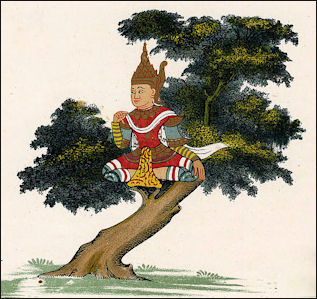
Burmese Yokkaso Nat (Spirit) Animal sacrifices are held by some ethnic minorities to help sick relatives, assure that good spirits watch over their children, and appease the spirits at healing ceremonies, weddings, house christening and births. In ascending order of importance, chickens, dogs, pigs and water buffalo are all sacrificed. A small ceremony to cure a cold may require only one chicken while the wedding of the son of a chief might result in the sacrifice of many water buffalos. Occasionally, a pig is sacrificed for no other reason than because people are hungry for meat.
In a sacrifice, the spirits only take the spirit of the dead animal, which means that animal itself, including the meat, the ears, nose and tail, eyelashes and hoof slivers, are divided among the villagers. The Thai government used to have a tax on sacrificed animals which some tribes skirted by claiming the animal accidently hung itself, and they had no other choice but to slaughter it.
Masks and costumes are commonly used by members of animist tribes during dances and ceremonies. Often they represents a particular spirits, and when people put them on they becomes possessed by those spirits. People who wear masks ands costumes often have to go through an initiation ceremony before they are allowed to wear them. The secrets of the costumes have traditionally been jealously guarded, especially by men from women and children. Ceremonies with masks and costumes date back to the Stone Age.
Some scholars speculate that the painting was developed by ancient hunters to kill the spirits of the animals to make them less formidable during the hunt and to prevent the spirits from coming back to haunt the hunters after the animals was killed.
Shamanism
Shaman are people who have visions and perform various deeds while in a trance and are believed to have the power to control spirits in the body and leave everyday existence and travel or fly to other worlds. The word Shaman means "agitated or frenzied person" in the language of the Manchu-Tungus nomads of Siberia.
Shaman are viewed as bridges between their communities and the spiritual world. During their trances, which are usually induced in some kind of ritual, shaman seek the help of spirits to do things like cure illnesses, bring about good weather, predict the future, or communicate with deceased ancestors.
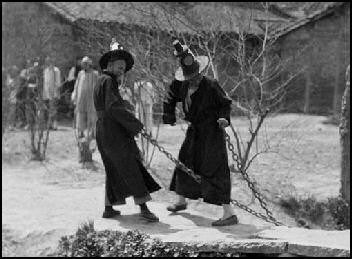
Chinese exorcism in the 1920s Shaman are generally poor and come from the lower social classes. Sometimes their spiritual power is seen as so great that they need to be separated from society. In the past, it is believed, almost all villages had a shaman and they were members of a caste that passed their traditions down from generation to generation. Some shaman are afraid to reveal their secrets because they believe that after they pass on their secrets they will die.
Kohkan Sasaki, an expert on shamanism in Asia and professor at Komazawa University, told the Daily Yomiuri, “I think shaman tend to be females in societies where women are suppressed or discriminated against as an inferior gender. By associating themselves with the gods women are able to balance their power with men in such societies.”
Shaman Diversity
There is no definitive and precise definition of shamanism. “It would be better to speak of ‘shamanisms,’ in the plural,” Marjorie Mandelstam Balzer, an anthropologist at Georgetown University told National Geographic. Beliefs, practices, and rituals vary from person to person, because the path to becoming a shaman is above all a highly individual one. [Source: David Stern, National Geographic, December 2012 ]
David Stern wrote in National Geographic: “Similarities do exist, though: The ecstatic trance, or soul journey, as it’s sometimes called, is a signature phenomenon. But how shamans employ their instruments and spiritual insights varies greatly, as can the ritual’s ultimate purpose. Many shamans work alone, while others join large urban organizations that act as trade unions; the Golomt Center for Shamanic Studies in Ulaanbaatar claims around 10,000 members.

Manchu shaman “Most shamans in Central Asian countries, such as Kyrgyzstan and Kazakhstan, where Islam predominates, regard themselves as devout Muslims, and their rites are infused with the mystic traditions of Sufism. Swathed in virginal white smocks, they conduct their rituals at Muslim holy sites, and every ceremony includes extensive prayers from the Koran. In Siberia and Mongolia, shamanism has merged with local Buddhist traditions—so much so that it’s often impossible to tell where one ends and the other begins.
In Ulaanbaatar I met a shaman, Zorigtbaatar Banzar—an outsize, Falstaffian man with a penetrating stare—who has created his own religious institution: the Center for Shamanism and Eternal Heavenly Sophistication, which unites shamanism with world faiths. “Jesus used shamanic methods, but people didn’t realize it,” he told me. “Buddha and Muhammad too.” On Thursdays in his ger (a traditional Mongolian tent) on a street choked with exhaust fumes near the city center, Zorigtbaatar holds ceremonies that resemble a church service, with dozens of worshippers listening attentively to his meandering sermons.”
Shaman are different from priests in that they go into trances. They are also regarded as different from “medicine man," magicians who manipulate magical materials; "herbalists," doctors who uses plants with certain properties to cure patients; "Sorcerers," medicine men who practice black magic; and "witch doctors," sorcerers sought by people who are thought to be cursed or bewitched. In some societies, mediums are people who got into trances and hurt themselves in some way---slicing their tongue, burning themselves or poking a hole through their cheek---as they attempt to cure a sick person.
At one time healing priests were members of the elite class. Today they are treated with respect by elders, but often ignored by the younger generation.
Shaman Rituals and Techniques
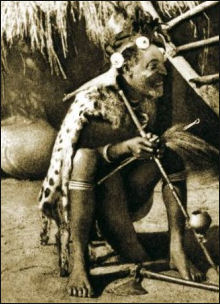
Pygmy shaman Shaman use various techniques to put themselves into trances: taking hallucinogenic drugs, asphyxiating themselves, and/or being taken over by hypnotic drums, dance rhythms or chants. When in a trance they have visions, speak in strange voices or languages, communicate with dead ancestors, gods, demons and natural spirits, and receive instruction from them about how to help the person who has sought the shaman's help. Maybe the patient has broken a taboo, offended a spirit or ancestor or lost his soul.
The shaman then carries out ritual directed a the particular problem that often involves communicating with the demon making the person sick and defeating or controlling him or seeking the help of a friendly spirit who will make the patient well again. Sometimes foreign objects are removed from patient's body in a symbolic ritual in which the object is sucked in and spit or vomited out.
People in shaman societies often believe that illnesses occur when the soul leaves the body and they are caused by certain events, witchcraft, unhappy spirits and ancestors, and/or problems within an individual's inner soul. These people often believe that if the soul remains out of the body for too long the patient dies. Shaman help patients to overcome their illnesses by calling on spirits to help the patients to get in contact with and bring back their souls.
Modern shaman are employed as exorcists, prophets, fortune-tellers, medicine men, healers and interpreters of dreams. Some write down messages they receive for the dead while in a trance. Some light a few a candles and say a few prayers or tell fortunes by throwing beans, coins, pieces of grain or some other method after you buy them a bottle of locally-made liquor. Others are brought in for major rituals.
Before rituals, the shaman often fast for a day or two. During the ritual they often don’t touch any food passed that is offered to the spirits, but help themselves to cupfuls of homemade liquor. It is generally thought that gods and spirits generally only take the spirit of the food and drink offered them. What remains is consumed by participants in the ritual.
Becoming a Shaman
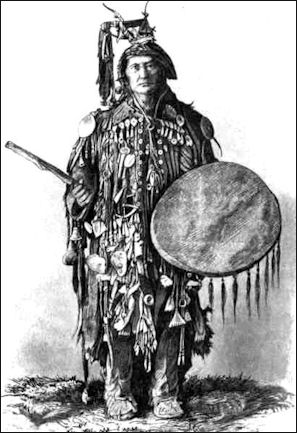
Siberian shaman and drum Shaman can be both men and women. Many are women. Traditionally, they have not chosen to become shaman but rather had shamanism thrust upon them. The process of becoming a shaman usually follows five steps: 1) a break with life as usual; 2) a journey to an "other world;" 3) dying and being reborn: 4) gaining a new vision: 5) and emerging with a deep sense of connectedness and purpose.
Most shaman begin their careers with a life-threatening illness, during which time they embark on a spiritual journey and communicate with the gods, spirits and ancestors that become the source of their powers. After recovering from the illness, they go through a long period of training, characterized by fasts and hardships and instruction from senior shaman that climaxes with a long period of isolation in which the shaman goes without food and experiences more visions.
One shaman told the anthropologist Zoe Avstreih: "While I was eating, a voice came and said, 'It is time: now they are calling you.' The voice was so loud and clear that I believed it and I thought I would just go where it wanted me to go....As I came out of the tepee, both my thighs began to hurt, and suddenly it was like waking from a dream...I was very sick. Both my legs and both my arms were swollen and my face was puffed up." [Source: “Path of the Shaman” by Zoe Avstreih]
Describing his journey into the other world the shaman said: "There was nothing but the air and the swiftness of the little cloud that bore me and those two men still leading up to where white clouds piled like mountains on a wide blue plain, and in them the thunder beings lived and leaped and flashed....Suddenly there was nothing but a world of cloud...there we were alone in the middle of a great white plain with snowy hills and mountains staring at us; and it was very still; but there were whispers." The shaman was then informed that he has been summoned to be taught. He was shown the history of his people, and instructed how to use herbs and finally awoke feeling healthy and reborn
Shaman Rituals
During shamanist rituals shaman do things like sip powerful rice wine mixed with the feathers of a sacrificed chicken through a long straw and, after becoming intoxicated, chant rhythmically to accompaniment of a brass gong. After each series of chants more wine is consumed and the shaman goes into a trance.
While in a trance shaman attempt to communicate with dead, the gods, demons and natural spirits and make out the form and destiny of a person's soul and heal illnesses with this knowledge. Illnesses, the ethnic minority people, believed was caused by straying souls who became influenced by demons. The shaman's objective was to bring the soul back, a task that was usually performed while in an ecstatic trance.
Shaman from the Yi ethnic group in China are known as “bimo” . Held in the highest respect, they carry out sacrifices and perform healing rituals with incense and bowls of chicken blood while headmen are responsible for controlling ghosts with magic. Often bimo were the only people in a village who could read the sacred texts that included clan histories, myths and literature.
Shamanism in the Modern World
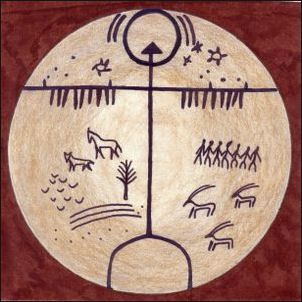
Shaman's Drum David Stern wrote in National Geographic: “Mystical figures are reviving old traditions throughout Mongolia, Central Asia, and Siberia and finding a receptive audience for their charismatic rituals. Shamans can be found in practically every corner of the planet—including in shamanic centers now in London, Boston, and many other Western cities. Shamans believe that unseen spirits permeate the world around us, act upon us, and govern our fates. By turns doctors, priests, mystics, psychologists, village elders, oracles, and poets, they are the designated negotiators with this hidden reality, and they occupy an exalted position within their societies.” [Source: David Stern, National Geographic, December 2012 ]
Shamanism has a “strong sense of individualism, deep respect for nature, and connection to the past. At its worst shamanism is quackery, and potentially dangerous, as when I saw a shaman tie a cloth strip tightly around the head of a man who may have suffered a skull fracture. The man’s eyes rolled back in his head, and he cried out in what sounded like excruciating pain. Some shamans claim that they can cure cancer, which strains credulity.
“Adherents swear that it is genuine, recounting life transformations and miraculous cures. In 2007 author Rupert Isaacson and his wife, Kristin, took their five-year-old son, Rowan, who has autism, to a Tsaatan shaman in Mongolia named Ghoste. When I spoke to Isaacson recently, he conceded that he can’t prove that the shaman helped his son—all he can do is point to the change that occurred almost instantaneously: “When we went out,” he said, Rowan was “incontinent, had tantrums all the time, and was unable to make friends. And when he came back, he was without those three dysfunctions.” Rowan continues to do better.”
Early Modern Man Religion
All that we know about the religion of prehistoric man is surmised from: 1) cave paintings, engravings and sculptures; 2) archaeological excavations of graves and sacred sites; 3) analysis of the way the dead were handled; and 4) studies of traditional hunter-gatherer societies.
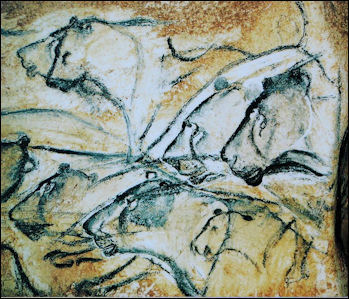
Chauvet cave lions made 27,000 years ago Traditional hunter-gatherer societies have a mystical attachment to the land and animals. Cooperation is an important virtue because it is vital foraging and hunting. Jean Clottes, a French art historian and archaeologist, who is regarded as the grand old man of cave art, told National Geographic, "Ice Age people probably believed that animal spirits lived in the rocks." The belief is similar to that of Aborigines.
Seventy-thousand- year-old skulls found in Placard cave near Charente and Dordogne Cave near the village of Les Eyzies in France and Castillo cave near Puente Viesgo Spain were made into drinking cups possibly for sacred rituals. Twenty-seven skulls from around the same period were found each in two caves in Nödlingen, Bavaria where from heads that had been cut off with a flint knife, dried, ceremoniously preserved in nest so that all the heads faced west. A 14,000 year-old half lion and half human head found in a French cave seems to suggest the worship of a supernatural being. [ World Religions edited by Geoffrey Parrinder, Facts on File Publications, New York]
The skull of a 160,000-year-old child found in Hero in 1997 was defleshed after death. Cut marks on the skull indicate the the skin, muscles and blood vessels were removed and lines were scraped on the skull, probably with an obsidian tool. The cut marks indicate that the bone was still fresh when it was done. This and the careful way it was done suggests that there was something more going on than mere cannibalism. The surface of the skull has a polished surface, which suggests repeated handling. Perhaps it was a greatly treasured relic. It was found with no other bones, possibly because it was separated from the body and buried in some kind of special funeral rite.
Early Modern Man Burial Practices and Religion

Neanderthal burial
A man was buried 100,000 years ago in Israel with an antler placed in his hand, perhaps an offering to be taken to the after life. A 20-year-old woman found in Santa Maria di Agnano cave near Maria di Agnano, Italy was buried 24,000 year ago with hundreds perforated shells in a red ocher paste covered her head. Beneath her right were the bones of a tiny fetus and lying behind her back was a 35-year-old male with similar perforated shells as well as a deer tooth necklace. Scientists are not sure how they died and
A thumb tip was found ritually buried at a 30,000-year-old site in Poland. A 7,000-year-old funerary mask that resembles a a hockey goalie mask was found in the Middle East. It was carved from white stone.
At Le Moustier in the Dordogne regaion of France the skeleton of a boy was found with his forearm under his head, a fine oval ax in his left hand and a pillow of flint chips under his head. Nearby were the burnt bones of a prehistoric ox which suggests a funeral feat was held. [ World Religions edited by Geoffrey Parrinder, Facts on File Publications, New York]
In Candide Italy the bones of 10,000-year-old stone age man, who had been eaten by a bear, was discovered. The body had been smeared with ocher and buried. In a cave in Monte Circeo Italy a skull, whose brains had been drained out, was found in a position that suggested veneration. Near Moscow, two boys laid to rest in a mound were buried with 8,000 valuable ivory beads, mammoth-ivory spears and assorted rings and anklets.
Neanderthal Religion and Burial Practices
It is possible that Neanderthals believed in spirits and the afterlife. Scientists speculate that Neanderthals possibly buried food and prized items with their dead for their trip to the afterlife as the Egyptians and many ancient cultures did. The practice of burying valuable items with the dead was practiced by the ancient Egyptians, Chinese, horsemen of the Central Asian steppe and others.
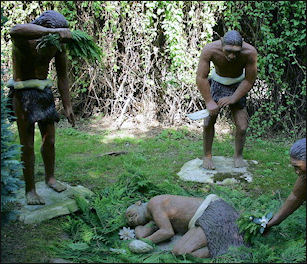
re-enactment of Neanderthal burial Neanderthals buried their dead. A headless Neanderthal skeleton found in Kebara cave in Israel was found in a shallow pit with its arms folded, suggesting formal burial rites. Scientists also argue that the fact that so many Neanderthal skeletons have been found in good conditional suggests burial. The remains of Neanderthals that are known to have buried their dead have been saved from erosion and damage.
Neanderthals, living 100,000 years ago in Central Europe, buried their dead with food, hunting weapons, charcoal and prized items such as tools, bear skulls, goat horns and medicinal flowers. Neanderthals buried their dead with blue hyacinth, yellow groundsel, knapweed and yarrow. One grave in Shanidar Iraq contained the remains of eight different flowers. The dead there were smeared with ocher, something Australian aborigines still do today.
Speculated on why so many 300,000-year-old Neanderthal bones were found at the bottom of 160-foot shaft in Spain, Juan-Luis Arsuaga of the Complutense University of Madrid told National Geographic, "They weren't brought here by carnivores. None of the bones have tooth marks...there are no tools so people weren't living here. Maybe they inhabited the entrance of the cave, and since corpses smell, they dropped the bodies of their dead down here to dispose of them. Perhaps there was ritual. Whatever the reason, they gave their dead special treatment. This tells us something about how their minds evolved. Animals don't take care of their dead."
Fetishes and the Case for Polytheism
The ancient Greeks and Romans practiced polytheism — the worship of many gods. Polytheists have traditionally been looked down upon by practitioners of the great monotheistic religion which worship only a single god — Judaism, Christianity, Islam — as primitive and barbaric pagans. But who knows maybe they had it right.
Mary Leftowitz, a classics professor at Wellesley College, argues that a lot of world’s troubles today can be blamed in monotheism. In the Los Angeles Times she wrote, “The polytheistic Greeks didn’t advocate killing those who worshiped a different gods, and they did not pretend that their religion provided all the right answers. Their religion made the ancient Greeks aware of their ignorance and weakness, letting them recognize multiple points of view. ..It suggests that collective decisions often lead to better outcomes. Respect for a diversity of viewpoints informs the cooperative system the Athenians called democracy.
“Unlike the monotheistic traditions Greco-Roman polytheism was multicultural...The world, as the Greek philosopher Thales wrote, is full of gods, and all deserve respect and honor. Such a generous understanding of nature called the ancient Greeks and Romans to accept and respect other people’s gods and to admire (rather than despise) other nations for their own notions of piety. If the Greeks were in close contact with a particular nation they gave their foreign gods names of their own gods: The Egyptian goddess Isis was Demeter; Horus was Apollo and so on.”
Menstrual fluids are often regarded as a pollutant while semen is used in rituals "improving health and well being." The word "fetish" was coined by Portuguese explores to describe the charms worn and Africans they trades with beginning in the 15th century. "Totem" was a North American Indian word describing a carving of an animal or human that was worshiped but not sacrificed. "Taboo" was a Polynesian word that meant d"prohibited"
See Separate Articles Under Greek and Roman Religion
Image Sources: Wikimedia Commons
Text Sources: New York Times, Washington Post, Los Angeles Times, Times of London, Yomiuri Shimbun, The Guardian, National Geographic, The New Yorker, Time, Newsweek, Reuters, AP, Lonely Planet Guides, Compton’s Encyclopedia and various books and other publications.
Last updated January 2022

